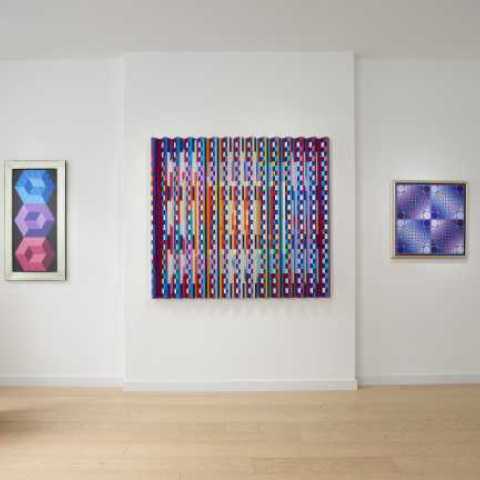Omer Tiroche Gallery
First Floor
21 Conduit Street
London
W1S 2XP
United Kingdom

Omer Tiroche Gallery is pleased to announce our forthcoming exhibition Vasarely/Agam: In Pursuit of Op. Bringing together works by Optical Art pioneers Victor Vasarely (1906 - 1997) and Yaacov Agam (b.1928), the exhibition celebrates the enduring legacy of these visionary artists and their ground-breaking contributions to the Op Art movement.
Agam and Vasarely were first introduced in Paris during the early 1950s by Denise René, a pioneering gallerist in the realm of geometric abstraction. René, with her eponymous gallery in Paris, played a pivotal role in promoting abstract and kinetic art during the mid-20th century, recognising the potential of both Vasarely and Agam early in their careers. In 1955, together with Vasarely, and art historian Pontus Hultén, René curated the influential group exhibition, Le Mouvement, which ignited a fresh perspective on kinetic art. This landmark event introduced a cohort of emerging younger artists such as Agam, Soto, Bury, and Tinguely while juxtaposing their burgeoning artworks with those of established masters like Calder, Duchamp, and Vasarely himself. Ten years later, the artists participated together in MoMA’s 1965 blockbuster exhibition, The Responsive Eye, where they exhibited alongside Josef Albers, Agnes Martin, and Frank Stella. The exhibition introduced Kinetic and Optical art to America, consecrating the movement, and inaugurating new frontiers for the study of perspective.
Born in Hungary in 1908, Victor Vasarely is widely recognised as the ‘grandfather’ of Op Art and leader of the movement. Originally training in medical science, Vasarely then turned his eye to visual art, approaching it with a will of method and objectivity not dissimilar to that of a scientist. After initial infatuations with Cubism, Futurism, and Symbolism, Vasarely developed his signature style in the late 1940s, a blend of geometrical forms, colours, and repetitive patterns that examined the way human brains absorb and process visual information. In Tridim Har, 1980, Vasarely challenges the viewer’s perception of reality through a juxtaposition of several cubes in a myriad of colours, crafting an optical illusion and fracturing the perspective plane. Fascinated by technology, physics, and sci-fi, Vasarely’s intuitions and theories helped define the psychedelic culture of the 1960s, leading to developments in neuroscience, quantum physics and experimental psychology. By this time, he had created and patented his Plastic Unit, the basis of his Plastic Alphabet.
Yaacov Agam was born in Israel (at the time Mandate Palestine) in 1928 before moving permanently to Zürich in 1949 and then on to Paris in 1951. In Zürich, he studied at the Kunstgewerbe Schule, under the renowned colour theorist Johannes Itten and was greatly inspired by the creations of Swiss artist Max Bill. Similarly to Vasarely, Agam was also an inventor and was interested in exploring the relationship between art and the viewer. Whilst principally a multimedia artist, he is most celebrated for his creation of the Agamograph; an artwork that incorporates several images that are sliced into strips and interlaced together to illustrate different images depending on the angle from which it is viewed. Paris, 1990-1991 is indicative of this concept as the boldly coloured picture plane is fractured in multiple surfaces and shapeshifts according to the viewer’s engagement with the work. Agam takes Vasarely’s concept of optical distortion one step further by blurring the boundaries between painting and sculpture.
Today, both Vasarely and Agam are hailed as pioneering icons of Post-War Art. Their ground-breaking approaches to artmaking continue to inspire new generations of artists to push the boundaries of what is possible, challenging conventions and revolutionising both Kinetic and Abstract Lenticular art by redefining the way we perceive and interact with art.
